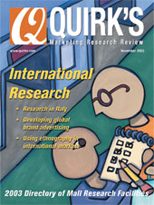Editor’s note: Sharon Seidler is senior vice president of C&R Research, Chicago.
Wanted: Large corporation seeks bright, aggressive, analytic person, preferably with market research experience and a graduate degree, to watch group interviews from behind a mirror. Must be able to tolerate long periods of time in a dark room. A “plus” if you like M&Ms, popcorn and other assorted salty and sweet snacks.
Additionally, you will be responsible for designing studies, analyzing data, writing reports, participating in team decisions, dealing with suppliers, and training new market research people. These other duties, however, need to be worked into and around the core job of observing group interviews.
Sound bizarre? Not really. I have heard from numerous clients that they are spending enormous numbers of hours “in dark rooms, watching consumers.” Certainly, we’ve come a long way from the days when manufacturers were not particularly in touch with their customers, when decisions got made on intuition or a little “mother-in-law” research.
But maybe we’ve come so far that we’ve overshot the target.
Do a little internal analysis of your own if you’re a company that buys qualitative research. Ask your market research staff to keep careful records on how they spend their work hours, then analyze hours spent on qualitative research, generally, and specifically, hours spent observing focus groups.
One of my clients did just that and the number was staggering — way out of proportion to the dollar percentage spent on qualitative.
What is the answer? Do fewer qualitative studies? Eliminate all observation of qualitative research? Hire more market research people to handle the load?
I believe that the answer lies in better use of the time allocated to qualitative research. Here are some guidelines:
1. Make distinctions among qualitative studies; they are not all of a similar magnitude of significance.
A seminal qualitative research study that launches an investigation into unfamiliar territory, with major ramifications possible, requires that the team be present throughout the study. Conversely, a communications check to “dot the i’s and cross the t’s” prior to a quantitative study does not warrant full attendance.
2. Form ongoing partnerships with qualitative professionals whom you trust. Then, let them operate independently.
Are you observing qualitative research groups or one-on-ones because you need to be there to make a contribution, or are you there because you are fearful that the interviewer might not do an optimal job, or might not understand what the project requires?
If it’s more of the latter, then the cure is not to attend all qualitative research, but to invest in a core group of trusted qualitative professionals:
- Take time to give the interviewer background on the study: secondary research findings, why the company is interested in this business, its position in the market, current hypotheses and goals.
- Build continuity with your qualitative suppliers. Make them part of your team. Subsequent segments of a continuing investigation should proceed smoothly as a result of initial investments.
3. Manage the study, don’t shadow it. Consider this scenario for basic, bread-and-butter qualitative studies:
- Day 1 of interviewing: brief the interviewer thoroughly before the interviews and stay for the first group or for the first few individual interviews. Then go back to the office for the rest of the day and address other tasks.
- Alternatively, check in by telephone to make sure the process is going well. Ask specific questions that go to both content and form. Perhaps convene at the end of the interviews for a debriefing.
- Subscribe to a service that allows you to watch interviews online. Periodically monitor the process.
In a quantitative project you wouldn’t parallel the person conducting the study, watching his/her every move. Qualitative research that involves a moderator who has truly internalized the issues will thrive even without hands-on management.
Note that some of the foregoing assumes that you are doing research locally, which you should probably be doing anyway since the right respondents can be recruited in most major cities. That is, a champion, or a user, of your products is a user if she/he lives in Chicago or Atlanta or Denver. Save geographical dispersion for a later quantitative study.
4. Make the most of a qualitative study in which you do actively participate. For those critical, high-profile “launching” studies, make sure that key people are there, in the back room. Engage observers so tat they are active participants via back room active listening techniques.
But also make sure everyone is not simply “bearing witness,” but also participating in team discussions. Schedule debrief meeting times between groups for the team to discuss learning, and also to make changes to the stimulus or interviewing flow, as needed. In other words, make the day one that meaningfully advances the study and the goals of the corporation. That is ultimately the best way to be respectful of team members’ time.
Make distinctions
In sum, qualitative research studies should not, like Pac Man of years ago, have to gobble your time in order to produce useful outcomes. Because not all qualitative studies are created equal, it is smart to make distinctions and be judicious with your time. Don’t micro-manage your study. Instead, form a bond with a group of qualitative professionals and be confident that they can act independently as your agents.
